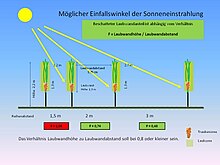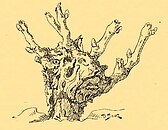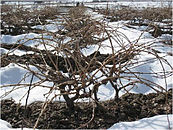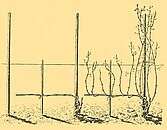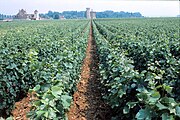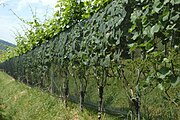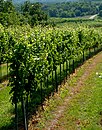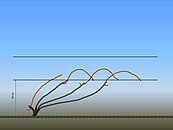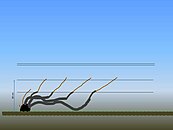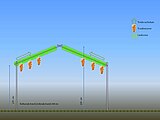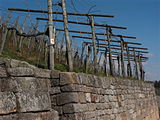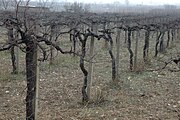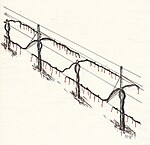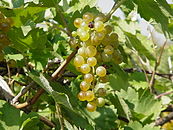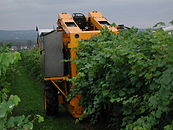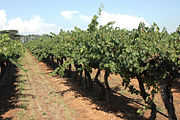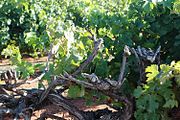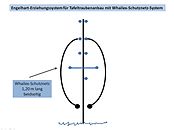Vine training
Under Vines is understood in viticulture all measures a characteristic Stock skeleton of the old wood of vines result, the planting distance, the support structure (mating, piles ( Stickelberger ), tension wires, etc.) and the section of the one-year wood (cutting length, arrangement, formation ) are decisive. This results in a certain educational system . Annual pruning measures (winter pruning, summer pruning - foliage work) counteract the acrotonic growth and the effects of apical dominance in order to maintain the chosen educational system. The education system is influenced by the grape variety , the intended quality, the amount of work and the characteristics of the area. In all educational systems, efforts are made to achieve, on the one hand, the best possible deciduous wall structure (to ensure quality and quantity) and, on the other hand, economic advantages. For the selection of the training system, among other things, it is also decisive whether wine or table grapes are produced and which harvesting method is used.
The term pruning means the annual pruning of the annual and partially perennial wood in order to maintain the vines in the system of the chosen upbringing. Other training systems are used for the propagation of stock vines . Cut vines are about 35 cm long shoot parts of underlay vines, which later form the root system of the vines, which are refined with a noble variety when the vines are propagated. Rootstock vines have a high tolerance (resistance) against the phylloxera root lice . The phylloxera is combated biotechnologically with the combination of rootstock and noble variety.
Basics
The vine is a climbing plant and therefore needs constant support. Vine plants have a strong tendency to grow upwards. The uppermost eye drives best when the fruit canes are upright ( apical dominance ). If vines were left on a support structure without intervening, they would soon climb the topmost holdings and the base would gradually become bald. This peculiarity of growth is an important property for the wild grape to survive in its struggle for light. This is known as the "acrotonic growth pattern".
This has the following consequences for the cultivation of vines:
- For longer cultivation and the necessary use of machines, the vines must keep their shape and must not grow ever higher.
- The pronounced and unchecked apical dominance favors vegetative growth and influences the generative performance (quantity and quality of the grape yield).
Grape zone
Under low and high upbringing, in addition to the lower stem, the height of the arrangement of the grape zone is essentially different. The closer the grape zone is to the ground, the more labor-intensive the care becomes. Grape ripening occurs earlier, which is a weighty argument in favor of growing areas in the north. The proximity of the grapes to the ground results in a qualitative advantage, but in areas with higher rainfall it is a considerable disadvantage. All fungal diseases that require moisture for infection, especially downy mildew , botrytis and black rot , are more pronounced here. A higher arrangement of the grape zone (80–130 cm and higher) results in a slight delay in ripening compared to a lower grape zone, whereby the influence on the acidity is stronger than on the sugar content. The risk of infection from fungal diseases is reduced. Today, due to climate change, the delay in ripening is no longer as important as it used to be.
Plant removal
Row spacing (row distance)
The height of the grape zone has an effect on the row spacing (line spacing). In cooler, more northerly growing areas (between 45th and 50th parallel), the distance between the foliage wall must be chosen so that the grapes are also exposed to sunlight during the ripening phase. If this is not the case, there is insufficient formation of primary aroma and color substances in the berries. Aromas, colorings and phenols - crucial for the quality of the wine - are only formed in well-exposed berries. This process depends on the temperature.
The distance between the rows and the distance between the stems in the row of vines give the planting distance. If the row distance is multiplied by the distance in the row, the standing space results. If the area of one hectare is divided by the planted area, one gets the number of vines / ha, the so-called planting or stick density .
Double-decker planting
A seedling (graft) is usually planted when planting vines. However, it is possible to halve the number of planting sites and to plant two seedlings (next to each other in the direction of the row) at each planting site. This halves the cost of supporting material and maintaining the young vines. The planting distance in the row is doubled. The maintenance of the floor space is thus improved. In principle, this method of planting can be used in almost all education systems. With double-decker planting, each cane can only unfold in one direction, which must be taken into account when cutting. This can lead to a certain distribution problem. You can alleviate this problem by not choosing double planting distances, but planting a little closer. This increases the planting density and reduces the yield burden on the individual vines. In spite of this, double-decker planting has not caught on in practice or has not become widespread in practice.
Hardwood wall structure
The training system is intended to achieve a good structure of the foliage wall, which is given by the fact that as many leaves as possible are exposed to direct sunlight during the day. Leaves that are constantly shaded do less, their photosynthesis conduction decreases. Leaves that do not receive direct sunlight (three-layer leaves) do not even produce as much energy as is necessary for their maintenance. These leaves are shed early (e.g. Silvaner ), they turn yellow.
Historical educational systems
The vine is a climbing plant , the wild vines grow on trees and spread their leaves over the treetops. The peoples who began to cultivate wine made this natural growth their own. Very early on in the cultivation of vines, the vine was given a support structure. Mostly these were simple wooden scaffolding, wooden stakes or existing branches of trees. In old pictures, a pruning is shown while the vines are being tended. It was recognized early on that the vines produce larger grapes with regular pruning.
Illustrations show that the Egyptians deliberately raised vines to produce wine. The first evidence of a private winery in Egypt comes from the biographical inscriptions from the tomb of Metjen in Saqqara . Metjen was a high official in the 4th Dynasty who owned a large house complex in the Nile Delta with an area of 11,000 square meters. The wine was probably mainly made for domestic consumption, but it cannot be ruled out that he had to contribute some of it to the royal court. There was plenty of space in this complex for a pond, lots of trees, garden land and farm buildings. The inscription about the vineyard says:
“A property 200 cubits in length and 200 cubits in width was laid out and furnished, planted with good trees; a very large pond was created in it; Figs and grapes were planted [...] Trees and grapes were planted in large quantities and a great deal of wine was made from them. "
In the form of education practiced by the Romans, beams are placed on four vertically arranged stakes, so that a kind of chamber is created. This historical type of education with the modifications as closed or open chamber building was still widespread in German viticulture, for example in the Rhine Palatinate, at the beginning of the 20th century.
- Historical forms of training (examples)
Classification of educational systems
The vine training systems can be divided according to different aspects. One problem with this is that the designation of upbringing is different in the wine-growing regions or countries, as these originated locally and are mostly associated with people ( Lenz Moser , Jules Guyot , Scott Henry and others) or areas by name. Many systems are similar in the structural system. The difference usually results from the characteristics of a variety , the possible or desired degree of mechanization and other economic circumstances. The wire frame support most commonly used today was not possible in the past. In the past, the vines were placed on trees, braided wood shoots, stakes (stake training, stick culture) or a wooden frame (perglare training).
On the one hand, education can be divided into intensive (e.g. trellis education, lyre education, etc.) and extensive systems (e.g. minimal cutting education ). On the other hand, the classification is based on whether a support structure is used or not. In the systems with the support structure a further breakdown can take place after the type of support used , after the distribution of shoots or foliage surface , after the distribution of the truncated fruit wood or whether to continue to row distance closer or working. Certain educational systems - mostly developed in America, Australia or New Zealand - are also referred to as "alternative educational systems".
According to the distribution of the shoots or the foliage area
-
- Vertical systems (e.g. trellis training): These are by far the most common form of vine training. The green shoots are formed in a trellis shape with several stitching wires. Depending on the height of the trunks raised and the design of the foliage wall, a distinction can be made between low and high training systems.
- Lower education systems: Are education systems in which a trunk of approx. 20–50 cm is brought up and a total height of approx. 1.3 m is reached. Due to the low overall height, row spacings of 1.20–1.5 m can be selected. The grape zone is close to the ground.
- High education systems: Are education systems in which the trunk is raised approx. 1 m or higher and a total height of approx. 2.3 m is reached.
- Between these, one can also speak of a medium-high system, with a total height of 1.6–1.8 m.
- Horizontal systems (e.g. pearl training): With these, the shoots are distributed over the entire surface on a corresponding framework. The processing measures are very complex below the support structure.
- Free-hanging systems: Are high education systems in which the green shoots can largely or completely develop freely. Only the trunk with a short or longer cordon needs scaffolding. The simple support structure is inexpensive, but must be erected in a very stable manner (e.g .: Casarsa education, vertical education, minimal education (minimal cut)).
- Vertical and free-hanging systems: some of the shoots are stapled vertically and some are free-hanging, e.g. B. the high culture according to Lenz Moser.
- Reverse education systems (e.g. Sylvoz education, Casarsa education)
After the support or the support structure
- Stake support
- Post support with wire frame scaffolding
- Wooden pole or wooden frame structure (e.g. chamber building, pergel education, Moselle pole, Trier wheel, stick education)
After distributing the cut fruit wood
-
- Education systems with trunk and cordon:
- Cordons (cordon trained) consist of perennial wood (old wood) and are built up horizontally or vertically. Short or long annual fruit wood is cut on them. These include the Lenz-Moser education, Sylvoz education, Casarsa education, vertical education, reversal education systems such as GDC and others. Usually, cordon education is always spoken of. But that alone does not characterize the educational system.
- Exchange cordon: One speaks of an exchange cordon when, after cutting a flat or half curve, it is not cut away in the coming winter, but all shoots are cut on short cones and this two-year-old cordon is only cut off in the following winter. For this purpose, a flat or half arch is cut again. This procedure is chosen in order to be able to make the advantages of a deep pre-cut with the machine. This results in an economic advantage for winter pruning. This is partially reduced again by increased foliage work in the grape zone.
- Education systems with trunk and head:
- There are systems of education with lower and higher trunks, in which a head-like thickening forms at the end over the years. Shorter or longer annual shoots are cut at the end of the trunk. Regular cutting back strengthens the end of the trunk and, after years, takes on a head-like appearance. The trellis education with flat arch, half arch cut, education with round arch cut, pendulum arch cut are among them.
Education systems with close or long row spacing
- This results in different planting densities , ie a different high number of vines per hectare. Depending on the training system and the distance between the plants, there are 1,500–10,000 vines per hectare.
- Narrow crops (row distance less than 1.8 m)
- Normal upbringing (row distance approx. 1.8–2.2 m)
- Wide-area culture (row distance of approx. 2.5 m and more)
In the second half of the last century, in the course of economic development and mechanization of agricultural production technology, a wide variety of vine training systems were developed and tested worldwide. A part has hardly achieved any practical importance. Most of the attempts have shown that the vertical positioning (espalier training) of the shoots, at a certain distance from the ground, has proven to be the most suitable training for mechanization. All educational systems have advantages and disadvantages. There is no ideal system of education. With his choice, the winemaker has to find the optimum between high-quality grapes for his intended wine quality or table grapes and the effort involved in their processing. The education systems differ depending on whether wine or table grapes are produced. When it comes to wine production, the focus is on the production of high-quality and healthy grapes with as little effort as possible.
Education systems without a support framework
These are lower forms of education, in which the vines (including the grapes) are almost on the ground or a cup-like stick is built up with old wood by cutting tenons. No support is used. This close-to-ground training is common in southern countries, where there is little or no rainfall in summer and autumn.
Creeping upbringing
The summer shoots grow without support on the ground (also known as soil training ). In other words, they crawl freely on the ground (also known as crawling education ). In this way, for example, wine is still grown in Santorini today: The vines are raised close to the ground and tied into cylinder-like baskets. This means that the vines defy the strong winds and the grapes are protected. The island's lack of water also does not harm the vines, which are deeply rooted in the permeable volcanic soil and can store moisture thanks to the way they are raised.
In Syria the vines have a lying trunk 1–2 m in length. The planting distance is (3–4) m × (2–4) m in the row. At the end of the trunk there are 4-6 legs, whereupon short cones are cut. This traditional old form of education is common in the vineyards of As-Suwaida , Damascus , Latakia and Idleb . During the maintenance of the floor, the trunk is turned several times in different directions. The turning causes cracks in the trunk. This often leads to disease. This is not a problem for the grapes, which are almost on the ground, as there is practically no rainfall from the end of May to October. The possibility of mechanization is very difficult. This upbringing has many disadvantages and efforts are being made to replace them with other forms of upbringing.
The "creeping education" is still used to some extent in the production of "rootstock" (cut vines) in southern wine-growing areas.
Small stone walls protect from the constant wind in La Geria (Lanzarote)
Vineyard in Lanzarote
Vineyard on Santorini (Greece)
Bush education
It is a lower form of education (Gobelet education, stool education, Alberello, Bäumchen , Busch, Bush Vines, En vaso, Vase, Basket Training (basket)), in which the green shoots of short cut cones often occur during the growing season be criss-crossed so that they don't become too long. No support is used. The bush education is an education system for weak-growing vines in low-precipitation wine-growing areas.
The gobelet system is one of the oldest types of vine training. This method was used by the Greeks in ancient times and adopted by the Romans. Today this form of vine training is particularly widespread in the Mediterranean region, for example in southern France, Spain, southern Italy, Turkey, Lebanon, Syria and in parts of Australia and South Africa.
This low education is a special form of head education. Short trunk with a spherical head that is more or less large, depending on the age, not higher than 20 to 40 cm above the ground, with 2 to 4, at most 5 short legs, well distributed around the head, each with a cone of 2 to 3 Eyes. Legs that have become too long are tapered using replacement pegs. As with the training of the head, the sticks are either given a short stake, or the summer shoots are allowed to support themselves by tying them together, or, as in hot, dry locations in France and Italy, the shoots for shading the ground are allowed to spread unhindered on it. The numerous disadvantages of this type of instinctual treatment do not encourage imitation. Pinning without a stake can only be achieved by shortening the summer shoots prematurely and weakening the entire vine as a result.
Educational systems with support structures
Tree education
This extensive, high education (= Alberate , also Alberata ) was very common in Italy in the past. The vines were raised to grow on or between trees (Alberate = sapling). Most of the time, the area was used in combination with arable crops. Small mulberry trees, maples, elms, chestnuts or poplars that were cut back every year (including those that had already died) served as support. Two to four vines were planted for each tree. There were local variants in the Italian regions of Emilia-Romagna, Tuscany and Veneto. In the Campania region , this form is cultivated and preserved as part of the DOC -Aversa as cultural heritage.
Stick culture (stake culture)
The stick culture, also called pile culture, was the most widespread education method in Austrian viticulture until the 1950s and 1960s . Each vine is supported with a single stake (stick). In Germany one speaks of the Moselle pile or single pile education, which is still widespread today , especially in the northern growing areas of the Moselle , Ahr and Middle Rhine . In Württemberg , instead, the three-legged pole education was widespread, in which each vine or its leg was trained on a pole.
In stock culture, around 8,000-10,000 vines per hectare (very high planting density) were planted, the trunk height being only about 20 cm. This results in a very close row spacing that can only be managed with a very high degree of manual labor. The close spacing also means that the grapes receive less sunlight and the vines are less well ventilated. In addition, the development of the vines near the ground causes an increased disease infestation. Due to the lack of workers and frost damage , the stock culture in Austria was gradually replaced by the high culture after the Second World War . The very low winter temperatures in January and February 1956 led to severe damage to the vineyards in the northern wine-growing regions and prompted a change in the upbringing and selection of more resistant grape varieties.
Moselle stake education
Moselle stake education still plays a role, especially on the Moselle . Two full arches (hangers) are cut on a small trunk (previously two with different heights). These whole arches are attached to the trunk or sticks below. The heavy cut (12–18 eyes / m²) favors high yields. The foliage work in summer is very labor-intensive. A mechanization of stick work is not possible. Ground maintenance is also hindered by low hanging shoots. It is a no longer up-to-date and mechanization-hostile educational system.
Trier slamka education
This high level of vine training was developed by Paul Slamka in Trier (D) for steep-slope viticulture . A plastic vine wheel is placed on the support pole at a height of 1.5–1.6 m as a distribution element for the fruit wood. The trunk is divided into 2-3 legs, on each of which a 30-40 cm long extensor with a short replacement cone is cut. The developing green shoots hang freely in all directions.
Vertical education systems
These are educational systems in which a vertical leaf wall ( trellis ) is formed with the help of several wires. The foliage wall is 20-30 cm thick. Only about 15 shoots should be formed per running meter, otherwise there will be compaction. Some systems have a vertically formed canopy and some of the shoots hang freely in the tramline. So an exact assignment is not always possible.
Low trellis education
In this low upbringing (known as Guyot upbringing in France - named after Jules Guyot ), a little trunk is raised on which one or two straighteners (flat arches) are cut, each with a replacement cone. In the past, trunks of approx. 25 cm, today 40 to approx. 70 cm, with a row distance of 1.10–1.50 m, were built up. This form of education is a frequently practiced form of education in European quality viticulture. Especially the more developed forms (with taller trunks and greater distance between rows) of the Guyot system are used today in intensive viticulture all over the world. The system enables a high degree of mechanization with reasonable construction costs. In the wine-growing regions, variants that differ slightly have developed for various reasons (variety characteristics, vigor, etc.).
Trellis education
Also known as normal education, unit normal education, standard espalier, VSP trellis (Vertical Shoot Positioning) in Australia and New Zealand and the like. a.). Today it is the most widespread education system for wine grape production worldwide. The shoots are stapled (stuck, tied or formed) vertically in tensioning wires. The shoots are held in place by several stapling wires. This formation creates a hedge-like appearance (total height approx. 2.20 m). The cut of the fruit wood can be done in different ways. Is the most widespread educational system in Germany today and is also gaining popularity in other countries. It is based on the work of Jules Guyot . Trunks of 70-90 cm are raised and one or two flat arches (straighteners), half arches or pendulum arches are cut on these in the row direction. These shoots are attached to tension wire. With the half and pendulum arch, the shoot is attached via an additional bending wire.
The number of tension wires can vary depending on the cut variant and the canopy work carried out:
- Wire frame with a movable pair of stitching wires and two or three fixed climbing wires.
- Wire frame with two movable pairs of stitching wires: for varieties that grow less upright and have less climbing ability (e.g. Silvaner , Müller-Thurgau , Kerner ).
- Wire frame with two movable pairs of stitching wires and a climbing wire: This variant is suitable when high canopy walls are intended or there is a strong crosswind effect.
- Wire frame for the use of a leaf stapler: only a simplified wire frame structure is required here.
- Wire frame for the use of rollable plastic nets: only a simplified wire frame structure is required here. The plastic nets can be rolled up on both sides of the leaf wall. These nets simplify the foliage work and give the leaves and shoots support and additional protection against hailstorms and against bird damage when the grapes are ripe.
Depending on the cut of the fruit wood, the following variants are known:
- Flat arch cut, stretch cut, single or double stretch arch
- The fruit cane (s) is attached flat to the bending wire.
- V-shaped short stretch cut
- Two short stretchers are formed in a V-shape.
- Semi-arch cut
- The semi-arch is bent downwards in a slight kink using an auxiliary bending wire and tied to the bending wire below.
- Pendulum arch cut
- The pendulum arch has two bending wires, just like the half arch. These have a greater distance (30–40 cm) compared to the semicircular training. The annual shoot becomes longer, that is, with more eyes than the semicircle. Strictly speaking, it is not a real pendulum bow, it should be able to hang freely.
- Cordon with tenon cut
- Two cordons are raised in the row direction at a height of approx. 70–90 cm. Several short cones are cut on it every year. With the alternate cordon cut, short cones are cut in the second year on the wood cut the previous year. These are removed again in the following year and the pruning begins as in the first year. So the cordon is renewed after the second year. The purpose of this procedure is to reduce the pruning time with pre-cutting machines, compared to when straighteners and semi-arches are cut. With the interchangeable cordon, the tying of the straighteners will be omitted at least in a year, since only short cones are cut. The pruning time can be reduced by alternating the pruning in rows. The short cut of cones, however, carries the risk that the grape zone becomes too dense and fungal diseases can occur more frequently. Increased foliage work in the grape zone is necessary. When choosing this shape, it should be taken into account that with some grape varieties the fertility of the eyes on the cones is too low.
Trellis training with cordon and tenons in Tuscany
Trellis training with cordon and tenons in Tuscany
Other espalier education systems
| Lyra education | |||
| The lyre training consists of a V-shaped (also U-shaped) supporting structure that opens upwards and was developed in France by Alain Carbonneau . The stems are raised 80 cm high. Compared to trellis training, the foliage wall is divided into two parts, so that even when the sun is high, direct sunlight can reach the inner leaves and the grape zone. Due to the very good structure of the canopy, the photosynthesis performance is improved. The support structure is very complex and requires a row spacing of 3–3.2 m. Some care work is associated with significantly more effort compared to other educational systems. The use of special machines is also difficult or impossible.
Disadvantages are the higher amount of foliage work and its timely implementation (especially with vigorous plants), the poor suitability for mechanical pruning, mechanical soil cultivation in the under-vines and mechanical grape harvesting. Due to climate change, however, a high degree of grape ripeness can also be expected in other education systems that require less effort and costs. In the USA in particular, the system was changed into different variants, e.g. B. the "Asymmetrical Lyra", the two leaf walls are arranged at different heights. |
|||
| Tatura espalier education | |||
| Tatura, a research institute in Australia (Victoria), developed an education system, which consists of two vine trunks inclined at 60 ° and the summer shoots, opening in a V-shape upwards. The system has a high production capacity, is difficult to mechanize and is of little importance in viticulture practice. In principle, this system is very similar to a lyre education, only larger. The basic principles of education are the same as education in lyre. | |||
| Trellis training for terraces | |||
| Vines can be grown on very steep terrain. A transverse terracing improves the possibility of mechanization and reduces soil erosion. A trellis formation in a single level leaf wall does not allow the transverse terrace to make optimal use of the sunlight that is available on the area. In order to make better use of space and solar energy, a fanned-out leaf wall directed downwards over the slope can be arranged in addition to the vertical leaf wall (with a wire frame). Different variants are possible. These training systems for terraces on steep slopes allow an increase in yield compared to conventional trellis training. The higher yield did not impair the quality of the must. The wines obtained also showed only minor differences in quality. The system enables more intensive use of space, but is associated with increased effort. | |||
| Floor education | |||
| Floor education has existed in the Rheingau before. A cordon was raised on house walls at a height of 70 cm and 70 cm above it (= a double-decker cordon) on a wooden slat frame. Vines grown in this way produced a high yield. Both the support and maintenance are very complex. In Australia and New Zealand, level training was developed in the second half of the 20th century due to the very strong growth of the vines. These have gained no importance in Europe. | |||
| Te Kauwhata Two Tier (TK2T) | Was developed by Richard Smart in the New Zealand experimental station Kauwhata in 1982. The education system consists of two leaf walls standing on top of each other. The trunks are raised in alternating heights, with cordons being built up in both directions to the next vine at a height of 40 cm. With the following vine, this is done at a height of 110 cm. This creates two leaf and grape zones at different heights. | ||
| Ruakura Twin Two Tier (RT2T) | Ruakura twin two row trellis system was developed in 1983 by Richard Smart at the Ruakura Research Station in New Zealand. Four leaf walls are formed on a very elaborate support structure. The system requires strong vines and ultimately a special grape harvester. This educational system has no meaning in Europe. | ||
| Scott Henry education (SH) | The vintner Scott Henry from Oregon / Umbqua Vally had problems in his vineyards (1972) with the very strong growth of the vines (leaf compaction, increased occurrence of fungal diseases, falling yields, low color intensity in red wine varieties) to get a grip on the vigor. By increasing the cut thickness from two to four long fruit canes, the vigor decreased. It was therefore necessary to distribute the increased number of shoots. Henry distributed the fruit rods on two device stations 30 cm apart. The shoots from the upper station (at a height of 130 cm) were tacked up and the shoots from the lower station (at a height of 100 cm) were tacked down. This created a foliage wall divided into two vertically. This form of training brings high yields and is suitable for mechanical harvesting.
This education system represents an interesting alternative to espalier education. The education system is used today in different variations in many wine-growing regions of the world. It is particularly interesting for locations where the shoot growth is very strong. The main advantage of the Scott-Henry system compared to trellis training is an approx. 60% larger leaf surface, thus a higher photosynthesis performance and higher yields. Under growing conditions that exist in European growing areas, it is not possible to cut so heavily. A SH variant was therefore developed at the FA Geisenheim. This only provides half the thickness of the cut, i.e. two long fruit sticks. |
||
| Smart Dyson parenting | Was developed in California in the 1980s. The system is named after the Australian Richard Smart and the New Yorker John Dyson. It is a cordon training in which the short cones are directed upwards and downwards. As in the Scott-Henry education, the developing instincts are formed up and down. This form of training brings high yields and is suitable for mechanical harvesting.
A system based on the Smart Dyson education system, which was developed in In King Vally (Australia), is the Ballerina system . |
||
High culture, Lenz Moser upbringing
The high culture, also called Lenz Moser education , is an education system with vines of approx. 100-130 cm and a row distance of 2.80-3.20 m ( wide area education ). It was developed by Lenz Moser in Austria (Rohrendorf near Krems / D.) From 1928. From the mid-1950s onwards, this education became widespread in Austrian viticulture. Lenz Moser published his experiences in the book Viticulture once differently in 1950. Due to the low number of vines per hectare, compared to the stock culture, the individual vines have to produce a higher yield in order to achieve the same area performance compared to denser planting. So each stick must bring more shoots to develop. More shoots also means more leaves. Lenz Moser divided the shoots (1/3 on the left, 1/3 in the middle into wire pairs, 1/3 on the right) so that they receive sufficient light. This results in a very good leaf area distribution. However, it is assumed that a row distance of over 2.8 m must be selected. From today's perspective, this very good leaf area distribution is a major obstacle to the use of grape harvesters, foliage cutting devices, vine pruning machines, tunnel sprayers and stick clearing devices. These are reasons that today no more trisection is practiced, as one has to forego a larger proportion of mechanization options. In addition, the low number of vines per hectare (approx. 2500–3000 vines / ha, d, p. 2.5–3 m² stand space per floor) easily leads to excessive individual vines and weakening the vines. The wider row spacing was not only easier to mechanize, but also enabled different types of soil maintenance. With larger row spacings and a higher grape zone, ground greening could be cultivated, which was not possible with stick culture.
In the high culture according to Lenz Moser, the following different upbringing variants have developed in practice:
| High culture with cordon | |
| Is that form of high culture that Lenz Moser practiced. Short extensions and cones were cut on a one or two-armed cordon. A third of the green shoots were distributed in the wires above and a further third each developed into the tramline. This achieved a good distribution of the leaves, especially if the stick was left with many eyes (which was previously common). Many shoots require good distribution. The division into thirds required sufficient line spacing.
Today this shape is hardly used any more, because on the one hand the division into thirds is no longer necessary due to the smaller incision on the eyes and on the other hand the use of different machines for stick care is an obstacle. The high culture is established today with narrower row spacings and the shoots are formed in a trellis-like manner in vertically arranged tension wires. |
|
| High culture with cross yoke - crown cut | |
| By attaching cross beams (30–50 cm, cross yoke) with two additional tension wires, cut fruit wood can be distributed across. Seen from above, this is a cross-like distribution of the cut extensors. This arrangement is also known as crown training. For a good third division, however, the row distance (aisle width) must be at least 3 m. The foliage distribution is unfavorable because some of the shoots come to lie on top of each other. This overlapping of shoots leads to a bell of leaves. The support structure causes higher costs and the cross beams are easily damaged during machine maintenance work. The use of various machines for stock care up to the grape harvester is only possible to a limited extent or not at all and is therefore of no importance. This form of high culture is no longer relevant today. |
|
| High culture with cross yoke - angled rod cut | |
| By attaching cross beams (30–50 cm, cross yoke) with three additional tensioning wires, cut fruit wood can be distributed across. The long fruit rods are attached at an angle using a bending wire. Two fruit rods with replacement cones are cut. This upbringing is also known under the name of Winkelruten-Weitraumhochanlage . For advantages and disadvantages, see crown cut. This form of high culture is no longer relevant today. |
|
| High culture with two-line cut | |
| On a trunk with a height of 1 m to 1.30 m, long stretchers (flat arches) are cut in both directions and attached to the tension wire. This form of education is very similar to espalier education. Only slightly higher tribes are raised. An advantage for all manual work, as this can be carried out standing. | |
| High culture with a semi-arch cut | |
| On a trunk with a height of 1 m to 1.30 m, a long semi-arch is cut on the tension wire in one or in both directions. These are formed and attached using a bending wire. This form of education is very similar to espalier education with half-arches. Only slightly higher tribes are raised. Compared to the flat arch, more eyes can be cut. In addition, the grape zone is distributed over a higher zone. The grape zone is loosened up. | |
| High culture with a heart cut | |
| A high form of education (also called heart-shaped education), with a row spacing of approx. 3 m, where two half arches and two full arches are cut at a height of 1 m. With these four long fruit stalks, you can achieve a strong cut in the vine. This upbringing was common in the former Eastern Bloc countries in order to achieve high yields. | |
Subject education
A form of education that was specially developed for the mechanical covering of the vines with soil to protect the vines against low winter temperatures. The vine is limited in its spread in areas and countries such as Moldova, Ukraine, Tajikistan, Uzbekistan, Bulgaria, Romania and certain areas in Hungary by severe winter frosts. At temperatures of -24 ° C and below, vines suffer frost damage. The floor cover of the lower trunk parts or folded trunk parts can thus be well protected against winter frost damage. In Italy this system of education is called Ventagli . A French fan education system (Éventail) with multiple arms lying flat on the floor. A cone and a short fruit cane are cut on each one. It used to be a common education system in Chablis with the advantage that protection against severe winter frosts was achieved by covering the arm parts with earth.
Horizontal educational systems
These are high education systems in which the shoots are drawn on a horizontal, mostly inclined wire frame. A more or less closed foliage roof develops (pergola training, roof arbor training) at a height of approx. 2 m. These systems are used for both wine and table grape production. They are called differently in the countries, so as pergola education or as pergola education ( South Tyrol ) etc. The appearance usually differs only slightly in structure. These trainings can produce high yields. This is important in table grape production. Today, this type of planting is often replaced by other, better mechanizable training systems when new plants are started.
Pergola made of wood and tensioning wires - South Tyrolean Pergl
Pergl education (South Tyrolean Pergl, Pergola Trentina, roof arbor education) is a high education system and, depending on the variant, has a horizontal or slightly inclined canopy. All maintenance work must be done from below. In South Tyrol, the pearl education, especially on steeper slopes, is still important. It is an essential characteristic element landscape that already in the second half of the 15th century in Bozen as "pergel zeylen" and in Tramin as "pergolas" was officially recorded. Due to the high level of maintenance and production costs and limited possibilities for mechanization, it is increasingly being replaced by espalier education. Today it is considered an outdated form of upbringing, as it no longer meets the requirements of modern and economical maintenance of a vineyard.
A distinction is made between the Simple Pergl on steep slopes and the closed Doppelpergl (Überetsch) and open Doppelpergl (Unterland and Bozner area). Depending on the arrangement or location, there are various designations: Ackerpergl (Pergl, which is used for culture in addition to field crops) , Grenzpergl or Markpergl (Pergl at the limit of a property) , Holzpergl or Stangenpergl (Pergl made of wood) , Mäuerleinpergl or Mauerpergl (Pergl on the front side of a vineyard, which extends from the upper edge of a drywall a tray extends) , Ortpergl (collective name for the vines to the front side of the vineyard) .
Pergola with wire mesh
The pergola education is prevalent in southern Italy, South America, Argentina, Brazil, Chile, Portugal, Lebanon and Syria. The trunks are raised 2.0–2.3 m high. Tension wires are attached to posts like a net (wire mesh pergl) over the entire area. The shoots and thus the leaf area are distributed horizontally over the entire area. Very long fruit sticks are cut at the head or short legs of the trunk and attached in a star shape in the direction of the rows and across them. In the same way, four cordons can be raised in all directions and the straighteners and cones cut on them. The training system is used for both table and wine grapes. With this form of education high yields can be achieved. Due to the high structure, the system is very labor-intensive and labor-intensive.
Pergola education with wire mesh in Syria near Aleppo
In the north of Portugal , where the Vinho Verde is grown, a traditional pergola education (Latada, Ramada) has been common since ancient times, mostly as a frame for fields with other arable crops. The support of the up to 4 m high scaffolding is made of wooden posts and granite stone. The very high, but very labor-intensive upbringing has the advantage that the risk of fungal infections in the growing area near the coast is reduced. Annual precipitation amounts of 1200 to 2000 mm are common.
Tanazukuri (Tana - Japanese frame, frame) is a roof arbor high education system that is used in Japan. In the Japanese wine-growing regions it rains abundantly and the high humidity requires the grapes to have a large clearance from the ground in order to keep the infection and development of fungal diseases within limits.
Pergola education with table grapes ( Thompson Seedless ), Chile
A roof arbor formed from the Kōshū grape variety
Special pergola shapes
| Pergoletta Romagnola | ||
| Is an Italian high education system in which two long rods are cut on a high trunk, which are attached to wires stretched at the sides. The system is used to cultivate table grapes. | ||
| Raggiera | ||
| Is an Italian high education system (also called Raggi), in which the vines are pulled at a height of approx. 2 (2.5) m on wires tensioned like a wheel spokes. The vines are pulled up on a central pole (or tree). usually several vines are planted in one place and pulled in different directions. The system is used to cultivate table grapes. | ||
| Tunnel pergola | ||
| Education for the cultivation of table grapes and raisins in areas with low winter temperatures (Afghanistan, Uzbekistan, partly China). It is a very old form of education. The vines are pulled on arched wooden rods. The tunnels are each built on their own, with a distance of 1–1.5 m from each other. The vines are planted between these tunnels. The entire vine is completely turned over in autumn and covered with earth to protect the vines from the very low winter temperatures (-30 ° C). In the spring, the vines are dug up, cut and attached to the wooden framework. The grapes hang in the tunnel. This shape represents a special adaptation to the very unfavorable winter conditions. | ||
| Reed pergola | ||
| Simple and inexpensive support structure that is used by small farmers on the Nile River. The table grapes produced are sold in local markets. | ||
Reversal education systems
Reverse education (a high education system) is when the cut fruit wood hangs freely down or is attached to a wire below. The trunks must be raised so that the green shoots have enough space when hanging down so that they do not lie on the ground. The main advantage is a simple support structure that is inexpensive. The drooping shoots can lead to the formation of bells and thus to foliage compaction. The result is poor penetration during crop protection work and increased disease infestation. There are a number of variations.
Sylvoz education
Was developed by the Italian winemaker Carlo Sylvoz (Northern Italy, Conegliano area). Fruit rods are cut with about 10 eyes and attached to a wire underneath. The one or two-armed cordon is raised at a height of 1.50–1.60 m.
| Styrian bow education | ||
| A variant of the Sylvoz education in Styria. At a trunk height of 140–150 cm (row distance 3 m) a one-armed cordon is raised downhill. Two (earlier more) long fruit arches are cut as fruit wood, bent downwards in a vertical direction and attached to a wire. A one- to two-eyed replacement tenon is cut for each arch. Good vigor of the vines is a prerequisite for this form of training. Two vines can also be planted per planting site (double-decker planting). It is not suitable for dry growing areas. The Hudson River Umbrella upbringing in the USA is identical to this upbringing. | ||
| Umbrella Kniffin | ||
| A modified form of the Hudson River Umbrella is the Umbrella Kniffin system . Two to four long arcs are cut on two short pieces of cordon. These are formed using a bending wire located above and attached to a tension wire arranged below. | ||
Casarsa education
This system is largely similar to the Sylvoz education. The long trimmed fruit sticks hang freely when they drop under their own weight.
| Horizontal high cordon training | ||
| Is a high one-wire upbringing. A two-armed cordon is raised on a strong tension wire at a height of 1.5–1.7 m. There are two variants depending on the length of the rod. Reversal of high cordon training with tenon cut and reversal of high cordon training with straight cut . The latter is similar to Casarsa training with double-decker planting. | ||
| Single wire training with double-decker planting | ||
| A variant of the Casarsa education in Styria. At a trunk height of 140–150 cm (row distance 3 m) a one-armed cordon is raised downhill. Two long fruit arches are cut to form the fruit wood, bent downwards in a vertical direction and attached to a wire. A one- to two-eyed replacement tenon is cut for each arch. Good vigor of the vines is a prerequisite for this form of training. Two vines can also be planted per planting site (double-decker planting). It is not suitable for dry growing areas. | ||
| Hanging high cordon training | ||
| The pole structure and the support structure is similar to the horizontal high cordon training , only with the difference that here the two cordon arms are shorter and not horizontally formed, but hang over the tension wire (height 1.5–1.7 m). Two medium-length straighteners are cut on the hanging cordons. | ||
| High wire system (two-wire system) | ||
| On two tension wires, 1.30 and 1.50 m high, a half-arch is cut on a trunk 1.30 m high, with the upper wire acting as a bending wire. The annual shoots develop freely hanging in all directions. The lower construction costs and maintenance work are advantageous over trellis training. | ||
| Geneva Double Curtain (GDC) | ||
| Developed in the early 1960s by Nelson Shaulis in New York State for the Concord grape variety . (GDC = Geneva Double Curtain, double curtain training ) Vines are pulled on a high T-shaped frame (also V-shaped). The cordon is built up along the yoke wires. By cutting the medium-length fruit wood, two hanging leaf curtains develop. The vigor is inhibited and the incidence of light improved. The aim of this system was to create a form of education for machine reading. The system is of little importance in America and Australia. In Europe it was only attempted and because of the high level of creation effort, the larger row spacing and the lack of special harvesting machines for the system, it has become of no importance. | ||
| Duplex education | ||
| This is similar to the GDC and was developed in California in the 1960s especially for machine reading. By cutting two long fruit stalks at a distance of 1 m, two hanging leaf curtains develop. | ||
Floor education (hanging freely)
Is an education system where long stretchers are cut on two tension wires arranged one above the other. The developing annual shoots hang freely.
| 4- (6) -arm kniffin system | ||
| Is today a widespread education system in North America, which is comparable to a flat arch section; it was used earlier in the Rheingau. The fruit wood is tied down flat on wires (but also in arches) at different heights (levels). The developing annual shoots hang freely in the tramline. There are several variants. Long stretchers (flat arches) are cut and fastened on two or three (if there is sufficient growth strength) tension wires. If the shoots are vigorous, the leaves and grapes on the lower tier can be overly shaded. Loss of quality is associated with it. | ||
Other educational systems
Vertical education
In this training, the trunk is lengthened with a straight, vertical cordon (vertical cordon - vertiko, cordon vertical). Short cones are cut on this. The system was developed by Vilém Kraus in the Czech Republic in the 1980s, derived from the upright cordon training practiced earlier. A cordon up to a height of 160 cm is built up vertically on a trunk 80-90 cm long. On this vertical cordon of 70–80 cm length, layers with several one- to two-eyed cones are cut at intervals of approx. 25–30 cm. The row distance must be at least 2.5 m, preferably 3 m (larger canopy diameter - freely hanging shoots). By removing the point at an early stage , the different strength of the eyes is counteracted. A stable wire frame with one or two strong tension wires (3.5–4 mm) at a height of 140 cm is required as a support structure. Round iron bars (8-10 mm) with a length of 170-180 cm are used as trunk and cordon support. These piles are attached to the tension wire at a height of 140 cm. The disadvantage is that the suitability of the variety is different. The varieties Grüner Veltliner , Rheinriesling , Rotgipfler , Blauburger , Weißer and Blauer Burgunder , Schwarzriesling and Dunkelfelder are very suitable. Traminer , Sauvignon Blanc , Blauer Portugieser , Dornfelder and Blaufränkisch are not suitable for this training. Further problems are the formation of bald spots and uneven growth in the upper and lower areas of the cane. Education in the Czech Republic, Slovakia and Austria became less widespread in the last century. Due to the disadvantages mentioned, new plants are no longer being built.
Minimal cutting education
With the search for cost minimization, Australia experimented with non-cut systems decades ago. The minimal pruning training reduces the winter pruning, after the changeover, to very few corrective prunings of overhanging shoots. Is an extensive high education system with the aim of significantly reducing the workload per hectare. The workload / ha is approx. 50–70 Akh / ha. With the conversion, the structure of the foliage wall and the grape zone of the vine is completely changed compared to a conventional upbringing. The shoot length of the individual shoots decreases sharply, but the number of shoots is significantly higher, as significantly more eyes remain on the stick due to the non-cut and sprout. This system corresponds to the natural development of the vine on bushes and trees (also known as natural growth education ). Actually, all other educational systems in which the cane is cut back to a few eyes represent a certain rape. Few eyes per vine result in a limited above-ground instinct development. This is reflected in the development of the root system. Many shoots with the plant switching centers of the shoot tips (phytohormones) cause more intensive root growth, which manifests itself in a lower susceptibility to stress. Despite high yields and satisfactory sugar production, the vines do not collapse due to overload. The majority of the shoots and their leaf area are located in the outer area of the foliage wall. Inside the vine is balding. After the conversion, it takes a few years for a growth and yield equilibrium to be established. The suitability or reaction of the grape varieties is different. There are good and unsuitable grape varieties for this system. Due to the very large number of grapes, the weight of the individual grapes decreases. The smaller grapes are looser and the berries themselves smaller. Unfortunately, this advantage, which reduces the risk of infection by fungal diseases, does not apply to all varieties. The system is designed for the use of grape harvesting machines and can therefore only be practiced in a corresponding meadow garden area with a large row spacing (approx. 2.8-3.5 m). In Australia, experience has been gained and applied for a long time. At the end of the last century tests were carried out in Germany and subsequently also in Austria. There is still little practical experience with this system in Europe and with our native grape varieties and climatic conditions.
Minimal cut trellis training
This minimal cut variant, which has not yet been tried and tested, is an education that is easier for the winemaker to accept than the actual minimal cut education. With this training, the existing wire frame of the trellis training (2 m row spacing) is retained. In terms of appearance, too, it largely corresponds to trellis training. When converting, the waste wood is well distributed and fastened over the entire wire frame. Opposing tension wires must be stapled together well. Compared to trellis training, manual pruning and binding and tacking work are completely eliminated. In winter, mechanical pruning is necessary so that the "trellis" is preserved. During the growing season, the system is kept in shape with one or two trimmings. With this procedure, the diameter of the foliage wall is not as large as with the minimum pruning with 3 m row spacing. This enables a better use of a grape harvester for thinning grapes. This allows the problem of the often very high yields of minimal cutting systems to be better regulated. A large number of small clusters develop on short shoots on the foliage wall. With the different distance from the ground there are noticeable differences in ripeness and if not thinned out, there is a ripening delay of 6–12 days. This should not be seen negatively in the course of global warming.
Minimal cut espalier training after budding - Blauer Portugieser
Blue Burgundy - Loose distribution of grapes over the entire foliage wall
Minimal cut cordon training
In Australia (MPCT - Minimal Pruned Cordon Trained ) used high training system with cordon training and mechanical winter pruning. After the cane has been built up and the cones have been cut, only short shoots are mechanically cut back in the direction of the cordon in the years of harvest. Is an extensive system to significantly reduce the amount of work involved in pruning.
Medium high cordon training
Only a single, two, three or four wires, the lowest at a height of 70 cm, are stretched as support. Starting from the trunk, a cordon is raised on the wire. The summer shoots develop in all directions. The proximity of the shoots to the ground requires that there is no precipitation during the grape ripening period. This form of support is widespread in South Africa, Australia and America. The summer shoots are not put to sleep, but hang more or less freely and shade the grape zone. This shading effect is desirable because the sun's rays in the countries mentioned are usually too intense and the grapes are damaged by sunburn . Most white wine varieties are affected by sunburn damage. In this form, this system is not used in the temperate climate zones (40–50 ° north latitude).
Training systems for table grapes
In table grape production, the educational systems must meet different requirements than those in wine grape production. The primary goal of the upbringing is that the grapes hang freely and that all maintenance work (foliage work, grape design, grape harvest) can be easily carried out at a comfortable working height.
conditions
The annual shoot development should be designed so that the grapes hang freely. Forming the fruit shoots at an angle of 45 ° has proven to be beneficial. The training system must ensure a secure hold for all shoots until harvest. A slipping of shoots on which too high a grape weight is hanging must be prevented. A leaf / fruit ratio of 2: 1 should be aimed for for good photosynthesis, that is 2 m² of leaf area for 1 kg of grapes. Direct and continuous sun exposure of the grapes is not desirable. Partial shade reduces the risk of sunburn. It is desirable that the grapes are protected from direct rainwater as much as possible and that they can dry off quickly when wet. A foil roof can help in areas with high rainfall. The manual harvest should be easy to carry out. Necessary plant protection work should be easy and effective to carry out.
Special training systems have been developed for table grape production. Horizontal and vertical training systems can also be used for table grape production. It is important that the shoot distribution meets the requirements of table grape production.
T, V or Y educational systems
These are similar systems in which the grapes hang freely due to the inclined position of the shoots (45 °). Another advantage is the protection of the grapes from direct sunlight and light rainfall through the canopy above. The V position of the drives can be achieved with horizontal cross yokes or V yokes. The support structure is designed either as T, V or Y. The V inclination can be chosen differently. The more open the V-shape is chosen, the larger the row spacing is required and the maintenance of the grape zone becomes more difficult. An inclination of the summer shoots of 45 ° has proven to be most favorable. The cross yoke of approx. 1.10 m (0.8–1.5 m) attached at a height of 1.9 m is covered with wires every 30 cm. The trunk height is typically 1.40 m. At this height and at 1.60 m there is a bending wire each. It is advantageous to attach a flat floor at a height of 1.90 m. The shoots that develop on it then distribute themselves better.
In the USA, the training system consists of a T-shaped support structure, with tension wires to hold the shoots or to which fruit wood is attached. This system has also been used for a long time in Afghanistan, South Africa and Saudi Arabia and it is a very old form of education there.
Arenenberger V-System
This system was developed in Switzerland and uses two horizontal transverse yokes (lower yoke 0.8 m and upper one 1.0 m long) at a height of 1.50 and 1.90 m. These cross yokes, which are covered with wires on the outside, absorb the summer drifts. The trunk height is 1.20 m, the pole spacing 1.20–1.70 m, line spacing 2.80–3.0 m. The summer shoots must be attached in several passes, otherwise they slide down. The Arenenberger system is offered complete with a roof.
Y education
The shoots grow upwards into a Y-shaped wire frame. The form is built in different variants, mostly with different angular positions.
Engelhart table grape education
This special education system for table grapes was developed by Josef Engelhart at the Bavarian State Institute for Viticulture and Horticulture in Veitshöchheim, based on the diamond education with diamond-shaped tension wires (see below - picture on the left). It consists of a support structure with posts made of wood or metal with a total height of 1.90 m. 40 cm wide cross yokes made of metal are attached to it. The bending wire for the flat arch is attached at a distance of 90 cm from the floor (stick spacing 1.00 to 1.50 m depending on the variety). The 40 cm wide yoke is attached 15 cm above the bending wire (with one wire each on the right and left). 3 pairs of stitching wires are placed over the yoke at a distance of approx. 25 cm. In May / June, the shoots are alternately led upwards one to the right and one to the left at a 45 ° angle and stapled every now and then. In July / August the foliage can be cut above. The grapes hang freely thanks to the 45 ° inclination of the shoot and can be protected from hail, birds and, as far as possible, from wasps by a protective net.
Pitched roof training (monopitch roof training)
This high upbringing, a modification of the Y upbringing, has a support structure in which the shoots from a height of 1.4–1.5 m, on a pitched roof of 1.2 m, at an angle of 45–50 °, be formed. The sun's rays reach the sloping foliage wall vertically. The grapes underneath are in the leafy shade and can be easily reached there. The system is used for the production of table grapes. Due to the one-sided nature of the support structure, stable anchoring is important because of the wind hazard.
literature
- Karl Bauer, Ferdinand Regner , Barbara Schildberger: Viticulture. 9th edition. avBook published by Cadmos Verlag, Vienna 2013, ISBN 978-3-7040-2284-4 .
- Edgar Müller, Hans-Peter Lipps, Oswald Walg: Viticulture. 3. Edition. Eugen Ulmer, 2008, ISBN 978-3-8001-1241-8 .
- Jancis Robinson : The Oxford Wine Lexicon. 3. Edition. Hallwag, 2006, ISBN 3-8338-0691-5 .
- Oswald Walg: Pocket book of viticulture technology. 2nd Edition. Fachverlag Fraund, 2007, ISBN 978-3-921156-78-0 .
Web links
- Josef Engelhart: Education systems for growing table grapes. Bavarian State Institute for Viticulture and Horticulture (PDF)
- Josef Engelhart: table grape information. Bavarian State Institute for Viticulture and Horticulture, Viticulture Department, Viticulture and Quality Management.
- Rolf Fox, Peter Steinbrenner: Contemporary vine training.
- Georg K. Hill, Sieghard Spies, Bernd Prior: Minimal pruning for the management of lost or frost-damaged vineyards. 2000 (PDF)
- Andrew Teubes: Trellising of Grapevines - increasing yield and quality. ( MS PowerPoint ; 9.3 MB) 2009.
- LVWO Weinsberg: table grape information.
- Dictionary of German winegrowers' language
- Pictures of vine training
Individual evidence
- ↑ Karl Bauer among others: Viticulture. 8th edition. Austrian Agrarverlag, 2008, ISBN 978-3-7040-2284-4 , p. 162.
- ↑ Fritz Schuhmann: Historic vines education types in the Palatinate. Academy of Sciences and Literature, Mainz. Franz Steiner Verlag, Stuttgart, special edition March 2002, p. 205.
- ^ Edgar Müller, Hans-Peter Lipps, Oswald Walg: Viticulture. 3. Edition. Eugen Ulmer, 2008, ISBN 978-3-8001-1241-8 , p. 299.
- ↑ Hans Reiner Schultz , Dieter Hoppmann, Marcon Hofmann: The influence of climatic changes on the phenological development of the vine, the suitability of the variety as well as must weight and acid structure of the grapes. Contribution to the Integrated Climate Protection Program of the State of Hesse (InKlim 2012) of the Viticulture Department of the Geisenheim Research Institute . Geisenheim 2005, p. 12 f./32 ff. (PDF file; 2.9 MB)
- ↑ cf. KB Godeckin: A Contemplation of the Meten's Inscriptions. P. 364.
- ^ TGH James: The Earliest History of Wine and Its Importance in Ancient Egypt. In: Origins and Ancient History of Wine. P. 204.
- ↑ The term "Kammert / Kammer" is derived from the Latin vinea camerata , which means "arched vine roof".
- ↑ The German winegrowing language - vines training types Open chamber building, illustration
- ↑ The German winegrowing language - Reberziehungsarten Kammert education, illustration
- ↑ Fritz Schuhmann: Historic vines education types in the Palatinate. Academy of Sciences and Literature, Mainz. Franz Steiner Verlag, Stuttgart, special edition March 2002, p. 213.
- ^ Fritz Schuhmann: Historical educational measures in viticulture. In: German Weinbau-Jahrbuch 1970. Waldkircher Verlagsgesellschaft, Waldkirch i. Br., Pp. 26-36.
- ↑ August Wilhelm von Babo , Edmund Mach : Handbuch des Weinbaues und der Kellerwirtschaft. 2nd Edition. Paul Parey Publishing House, Berlin 1893, p. 436.
- ↑ August Wilhelm von Babo, Edmund Mach: Handbuch des Weinbaues und der Kellerwirtschaft. 2nd Edition. Paul Parey Publishing House, Berlin 1893, p. 689.
- ↑ Adel Fardossi: viticulture in Syria. Diploma thesis 1978, University of Natural Resources and Life Sciences, Vienna, p. 96.
- ↑ a b Jancis Robinson : The Oxford Wine Lexicon. 3. Edition. Hallwag, 2006, ISBN 3-8338-0691-5 .
- ^ Müller Karl: Viticulture Lexicon. Paul Parey publishing house, Berlin 1930, p. 101.
- ^ Fiegl Jutta: The development of viticulture and the Heurigen system in Neustift am Walde. Dissertation. Vienna 1983.
- ^ A b Edgar Müller, Hans-Peter Lipps, Oswald Walg: Viticulture. 3. Edition. Eugen Ulmer, 2008, ISBN 978-3-8001-1241-8 .
- ^ Karl Bauer, Ferdinand Regner , Barbara Schildberger: Viticulture. 9th edition. avBook published by Cadmos Verlag, Vienna 2013, ISBN 978-3-7040-2284-4 , p. 188.
- ↑ a b c Volker Jörger, Marion Boos, Brigitte Ludewig: Is it all just a question of upbringing? (PDF; 260 kB) Landwirtschaft-mlr.baden-wuerttemberg.de, accessed on June 25, 2011 .
- ↑ Edgar Müller, Gerd Schulze, Oswald Walg: Weinbau Taschenbuch. 11th edition. Fachverlag Fraund, 2000, ISBN 3-921156-42-4 , pp. 102-105.
- ↑ Rollable protection. der-winzer.at, February 18, 2011, accessed on June 25, 2011 . (chargeable article, login required)
- ^ Arnold Schwab, Eberhard Grebner: Time-saving, partially mechanized V-stretch cut. Bavarian State Institute for Viticulture and Horticulture, Veitshöchheim
- ↑ Jancis Robinson: The Oxford Wine Lexicon. 3. Edition. Hallwag, 2006, ISBN 3-8338-0691-5 , p. 419.
- ↑ Karl Bauer among others: Viticulture. 8th edition. Austrian Agrarverlag, 2008, ISBN 978-3-7040-2284-4 , p. 169.
- ↑ Leigh Issell: The Tatura Trellis - construction. (PDF) dpi.vic.gov.au, July 1995, archived from the original on October 2, 2009 ; Retrieved June 25, 2011 .
- ^ F. Murisier, M. Ferretti, V. Zufferey: New vine education systems for steep slopes. ( Memento of the original from October 5, 2015 in the Internet Archive ) Info: The archive link was inserted automatically and has not yet been checked. Please check the original and archive link according to the instructions and then remove this notice. (PDF)
- ↑ Johann Philipp Bronner : Instructions for the useful planting of table grapes and other grape varieties. University bookstore by EF Winter, Heidelberg 1835, p. 58.
- ^ Richard Smart, Mike Robinson: Sunlight into Wine - A Handbook for Winegrape Canopy Management . Winetitles, Adelaide 1991, ISBN 1-875130-10-1 , p. 48.
- ^ Richard Smart, Mike Robinson: Sunlight into Wine - A Handbook for Winegrape Canopy Management. Winetitles, Adelaide 1991, ISBN 1-875130-10-1 , p. 63.
- ↑ Jancis Robinson: The Oxford Wine Lexicon. 3. Edition. Hallwag, 2006, ISBN 3-8338-0691-5 , p. 648.
- ^ Richard Smart, Mike Robinson: Sunlight into Wine - A Handbook for Winegrape Canopy Management. Winetitles, Adelaide 1991, ISBN 1-875130-10-1 , p. 43.
- ↑ C. Deppisch, HR Schultz, M. Lafontaine, B. Gaubatz, A. Bär, U. Craß, FA-Geisenheim: Scott-Henry - An alternative to trellis training? In: Deutsches Weinbau Jahrbuch 2007. Verlag Ulmer, ISBN 978-3-8001-5325-1 , p. 51.
- ↑ Jancis Robinson: The Oxford Wine Lexicon. 3. Edition. Hallwag, 2006, ISBN 3-8338-0691-5 , p. 662.
- ↑ Lenz Moser: WEINBAU with a difference. 1950, self-published, printed by Josef Faber, Krems / D.
- ^ Karl Bauer, Ferdinand Regner , Barbara Schildberger: Viticulture. 9th edition. avBook published by Cadmos Verlag, Vienna 2013, ISBN 978-3-7040-2284-4 , p. 192.
- ^ Karl Bauer, Ferdinand Regner , Barbara Schildberger: Viticulture. 9th edition. avBook published by Cadmos Verlag, Vienna 2013, ISBN 978-3-7040-2284-4 , p. 192.
- ^ E. Vogt, B. Götz: Viticulture. 6th edition. Verlag Eugen Ulmer, Stuttgart 1979, pp. 155, 156.
- ↑ W. Hillebrand: Vine education with a difference. In: German Weinbau-Jahrbuch 1987. Waldkircher Verlagsgesellschaft, Waldkirch i. Br., Pp. 59-69.
- ↑ a b P. Slamka, W. Kiefer: Experimental results on plant and education forms in viticulture in European countries with central planning. In: Deutsches Weinbau Jahrbuch 1990. Waldkircher Verlagsgesellschaft, Waldkirch im Breisgau, pp. 25–34.
- ↑ Alain Reynier: Manuel de Viticulture. 7th edition. 1996, ISBN 2-7430-0152-6 , p. 309.
- ^ Hannes Obermair : Bozen Süd - Bolzano Nord. Written form and documentary tradition of the city of Bozen up to 1500 . tape 2 . City of Bozen, Bozen 2008, ISBN 978-88-901870-1-8 , p. 167 ff., No. 1187 and 1217 .
- ↑ Hansjörg Hafner, Paul Hafner, Friedrich Menke, Josef Sölva, Manuela Unich, Meinhard Zöschg: New systems in viticulture. South Tyrolean advisory ring for fruit and wine growing, Kaltern 1999, p. 100.
- ↑ Pergel. winzerssprache.de, accessed on June 25, 2011 .
- ↑ Jancis Robinson: The Oxford Wine Lexicon. 3. Edition. Hallwag, 2006, ISBN 3-8338-0691-5 , p. 707.
- ^ André Dominé: Wine. Verlag Könemann, 2000, ISBN 3-8290-2765-6 , p. 806.
- ↑ Jancis Robinson: The Oxford Wine Lexicon. 3. Edition. Hallwag, 2006, ISBN 3-8338-0691-5 , p. 694.
- ^ A b Paul Domoto: Constructing a Vineyard Trellis. (PDF; 1.5 MB) (No longer available online.) Viticulture.hort.iastate.edu, January 26, 2002, archived from the original on October 27, 2011 ; Retrieved June 25, 2011 . Info: The archive link was inserted automatically and has not yet been checked. Please check the original and archive link according to the instructions and then remove this notice.
- ^ Agricultural Extension Service - The University of Tennessee: Grape Growing in Tennessee. PB1475-4M-03/01 (PDF)
- ↑ H. Redl, W. Ruckenbauer, H. Traxler: Viticulture today. 3. Edition. Leopold Stocker Verlag, Graz 1996, ISBN 3-7020-0725-3 , p. 309.
- ↑ Tim Ochßner, Karlsruhe: What to watch out for in new systems. In: The Baden winegrower. 11/2010.
- ^ Richard Smart, Mike Robinson: Sunlight into Wine - A Handbook for Winegrape Canopy Management. Winetitles, Adelaide 1991, ISBN 1-875130-10-1 , p. 52.
- ↑ Jancis Robinson: The Oxford Wine Lexicon. 3. Edition. Hallwag, 2006, ISBN 3-8338-0691-5 , p. 268.
- ↑ Jancis Robinson: The Oxford Wine Lexicon. 3. Edition. Hallwag, 2006, ISBN 3-8338-0691-5 , p. 576.
- ↑ H. Redl, W. Ruckenbauer, H. Traxler: Viticulture today. 3. Edition. Leopold Stocker Verlag, Graz 1996, ISBN 3-7020-0725-3 , p. 308.
- ^ Karl Bauer, Ferdinand Regner , Barbara Schildberger: Viticulture. 9th edition. avBook published by Cadmos Verlag, Vienna 2013, ISBN 978-3-7040-2284-4 , p. 196.
- ↑ Rudolph Goethe: Fruit and grape growing. Paul Parey Publishing Bookstore, 1900.
- ↑ Hans R. Schultz: Minimal cutting systems. ATW report 109, 2002, Board of Trustees for Technology and Construction in Agriculture, Darmstadt
- ↑ Team Viticulture Management; Arnold Schwab: Naturwuchserbildung (minimal cut) experiences in Franconia 1999–2007. (PDF; 2.0 MB) (No longer available online.) Lwg.bayern.de, formerly in the original ; Retrieved June 25, 2011 . ( Page no longer available , search in web archives ) Info: The link was automatically marked as defective. Please check the link according to the instructions and then remove this notice.
- ↑ Arno Becker: minimal cut: natural growth with a system. (PDF; 714 kB) weinbau.ch, accessed on June 25, 2011 .
- ^ Roger Nüßlein, Arnold Schwab: Minimal cutting education - results from Franconia. (PDF; 461 kB) lwg.bayern.de, accessed on June 25, 2011 .
- ^ Richard Smart, Mike Robinson: Sunlight into Wine - A Handbook for Winegrape Canopy Management. Winetitles, Adelaide 1991, ISBN 1-875130-10-1 , p. 61.
- ↑ Oswald Walg: minimum cut - but in the trellis. In: The Baden winegrower. 6/2011, pp. 20-24.
- ↑ Andrew Teubes, Trellising of Grapevines - increasing yield and quality. 2009, PP presentation in English. Slide 29.
- ↑ Josef Engelhart: Education systems for the cultivation of table grapes. German Viticulture Yearbook 2010, Verlag Eugen Ulmer, pp. 25–32, ISBN 978-3-8001-5689-4 .
- ↑ Josef Engelhart: Education systems for the cultivation of table grapes. Bavarian State Institute for Viticulture and Horticulture ( Presentation slides as PDF ( page no longer available , search in web archives ) Info: The link was automatically marked as defective. Please check the link according to the instructions and then remove this notice. )
- ↑ G. Götz: Education systems depending on the type of operation . German viticulture 2006, 73, 14-18
- ↑ Josef Engelhart: Education systems for the cultivation of table grapes. German Viticulture Yearbook 2010, Verlag Eugen Ulmer, pp. 25–32, ISBN 978-3-8001-5689-4 .
- ↑ Andrew Teubes, VG Nurseries: Development of Grapevines for the T-trellis system. 2009, PP presentation in English, slide 16.
- ↑ Josef Engelhart: Education systems for the cultivation of table grapes. German Wine Yearbook 2010, Verlag Eugen Ulmer, ISBN 978-3-8001-5689-4 , pp. 25–32.
- ↑ Klaus Gersbach, Andreas Wirth Strickhof: Table grape cultivation in Northern Switzerland. Strickhof 2006 (PDF)
- ↑ Andrew Teubes, Trellising of Grapevines - increasing yield and quality. 2009, PP presentation in English. Slide 17.
- ↑ Josef Engelhart: Education systems for the cultivation of table grapes. Bavarian State Institute for Viticulture and Horticulture ( Presentation slides as PDF ( page no longer available , search in web archives ) Info: The link was automatically marked as defective. Please check the link according to the instructions and then remove this notice. )
- ↑ Andrew Teubes, Trellising of Grapevines - increasing yield and quality. 2009, PP presentation in English. Slide 38.


